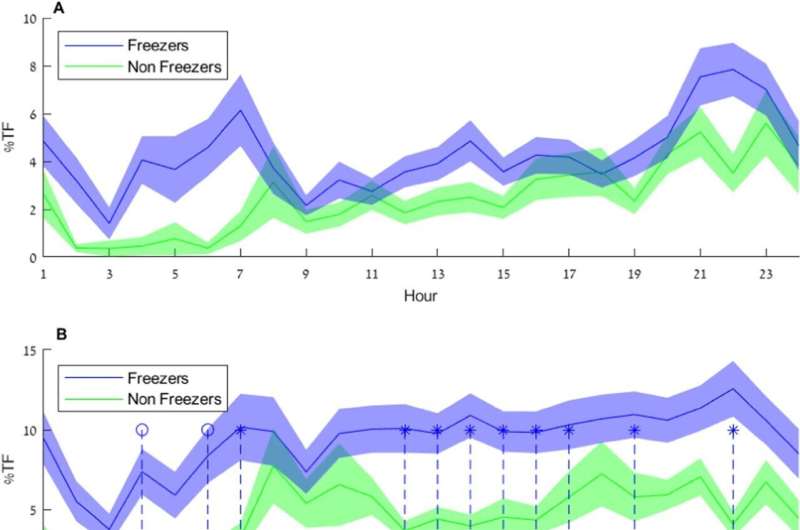This article has been reviewed according to Science X's editorial process and policies. Editors have highlighted the following attributes while ensuring the content's credibility:
fact-checked
peer-reviewed publication
trusted source
proofread
Worldwide machine learning contest advances wearable tech for Parkinson's disease

Researchers at TAU's Faculty of Medical & Health Sciences invited the international community of machine learning researchers to participate in a contest devised to advance their study and assist neurologists: developing a machine learning model to support a wearable sensor for continuous, automated monitoring and quantification of freezing of gait (FOG) episodes in people with Parkinson's disease. Close to 25,000 solutions were submitted, and the best algorithms were incorporated into the novel technology.
The study was led by Prof. Jeff Hausdorff from the Department of Physical Therapy at the Faculty of Medical & Health Sciences and the Sagol School of Neuroscience at Tel Aviv University, and the Center for the Study of Movement, Cognition and Mobility at the Tel Aviv Medical Center, together with Amit Salomon and Eran Gazit from the Tel Aviv Medical Center. Other investigators included researchers from Belgium, France, and Harvard University.
The paper was published in Nature Communications and featured in the journal's Editors' Highlights.
Prof. Hausdorff, an expert in the fields of gait, aging, and Parkinson's disease, explains, "FOG is a debilitating and so far unexplained phenomenon, affecting 38–65% of Parkinson's sufferers. A FOG episode can last from a few seconds to more than a minute, during which the patient's feet are suddenly 'glued' to the floor, and the person is unable to begin or continue walking.
"FOG can seriously impair the mobility, independence, and quality of life of people with Parkinson's disease, causing great frustration, and frequently leading to falls and injuries."
Amit Salomon adds, "Today the diagnosis and tracking of FOG are usually based on self-report questionnaires and visual observation by clinicians, as well as frame-by-frame analysis of videos of patients in motion.
"This last method, currently the prevailing gold standard, is reliable and accurate, but it has some serious drawbacks: it is time consuming, requires the involvement of at least two experts, and is impracticable for long-term monitoring in the home and daily living environment. Researchers worldwide are trying to use wearable sensors to track and quantify patients' daily functioning. So far, however, successful trials have all relied on a very small number of subjects."
In the current study, the researchers collected data from several existing studies, relating to over 100 patients and about 5,000 FOG episodes. All data were uploaded to the Kaggle platform, a Google company that conducts international machine learning competitions.
Members of the worldwide machine learning community were invited to develop models that would be incorporated into wearable sensors to quantify various FOG parameters (e.g. duration, frequency, and severity of episodes). A total of 1,379 groups from 83 countries rose to the challenge, ultimately submitting a total of 24,862 solutions.
The results of the best models were very close to those obtained through the video analysis method, and significantly better than previous experiments relying on a single wearable sensor. Moreover, the models led to a new discovery: an interesting relationship between FOG frequency and the time of day.
Co-author Eran Gazit notes, "We observed, for the first time, a recurring daily pattern, with peaks of FOG episodes at certain hours of the day, that may be associated with clinical phenomena such as fatigue, or effects of medications. These findings are significant for both clinical treatment and continued research about FOG."
Prof. Hausdorff says, "Wearable sensors supported by machine learning models can continuously monitor and quantify FOG episodes, as well as the patient's general functioning in daily life. This gives the clinician an accurate picture of the patient's condition at all times: has the illness improved or deteriorated? Does it respond to prescribed drugs?
"The informed clinician can respond promptly, while data collected through this technology can support the development of new treatments. In addition, our study demonstrates the power of machine learning contests in advancing medical research.
"The contest we initiated brought together capable, dynamic teams all over the world, who enjoyed a friendly atmosphere of learning and competition for a good cause. Rapid improvement was gained in the effective and precise quantification of FOG data. Moreover, the study laid the foundations for the next stage: long-term 24/7 FOG monitoring in the patient's home and real-world environment."
More information: Amit Salomon et al, A machine learning contest enhances automated freezing of gait detection and reveals time-of-day effects, Nature Communications (2024). DOI: 10.1038/s41467-024-49027-0


















